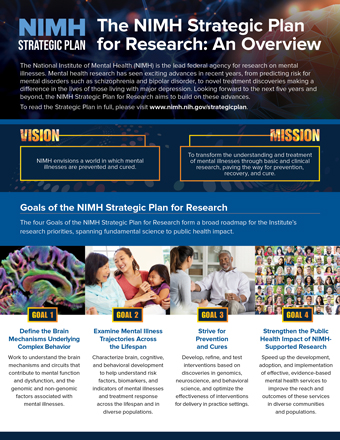The NIMH Strategic Plan for Research: An Overview
The National Institute of Mental Health (NIMH) is the lead federal agency for research on mental illnesses. Mental health research has seen exciting advances in recent years, from predicting risk for mental disorders such as schizophrenia and bipolar disorder, to novel treatment discoveries making a difference in the lives of those living with major depression. Looking forward to the next five years and beyond, the NIMH Strategic Plan for Research aims to build on these advances.
Vision
NIMH envisions a world in which mental illnesses are prevented and cured.
Mission
To transform the understanding and treatment of mental illnesses through basic and clinical research, paving the way for prevention, recovery, and cure.
Goals of the NIMH Strategic Plan for Research
The four Goals of the NIMH Strategic Plan for Research form a broad roadmap for the Institute’s research priorities, spanning fundamental science to public health impact.
Goal 1: Define the Brain Mechanisms Underlying Complex Behavior
Work to understand the brain mechanisms and circuits that contribute to mental function and dysfunction, and the genomic and non-genomic factors associated with mental illnesses.
Goal 2: Examine Mental Illness Trajectories Across the Lifespan
Characterize brain, cognitive, and behavioral development to help understand risk factors, biomarkers, and indicators of mental illnesses and treatment response across the lifespan and in diverse populations.
Goal 3: Strive for Prevention and Cures
Develop, refine, and test interventions based on discoveries in genomics, neuroscience, and behavioral science, and optimize the effectiveness of interventions for delivery in practice settings.
Goal 4: Strengthen the Public Health Impact of NIMH-Supported Research
Speed up the development, adoption, and implementation of effective, evidence-based mental health services to improve the reach and outcomes of these services in diverse communities and populations.
“NIMH’s broad portfolio aims to ensure that our research will have public health impacts across a range of timeframes—from the near-term to the far-off future. At NIMH, we’re proud of how far we’ve come, humbled by the distance yet to be traveled, and empowered by the hope that drives us forward.” – Joshua A. Gordon, M.D., Ph.D., Director of NIMH
Cross-Cutting Research Themes
Several research themes cut across and are integral to the Goals of the NIMH Strategic Plan for Research. These themes include:
- Prevention
- Global Mental Health
- Environmental Influences
- Comorbidities
- Translational Research
- Computational Approaches
- Harnessing the Power of Big Data
- Building the Research Workforce
Challenges and Opportunities
The NIMH Strategic Plan for Research outlines challenges facing mental health research, such as the burden of mental illnesses. The plan also presents research opportunities—for example, early intervention in psychosis, mental health equity, and digital health technology—to address these challenges.
Serving as an Effective and Efficient Steward of Public Resources
The NIMH Strategic Plan for Research outlines the Institute’s stewardship efforts, including setting priorities, managing programs and resources, and monitoring progress to advance the understanding and treatment of mental illnesses.
U.S. DEPARTMENT OF HEALTH AND HUMAN SERVICES
National Institutes of Health
NIH Publication No. 20-MH-8120
Reprints
The information in this publication is in the public domain and may be reused or copied without permission. However, you may not reuse or copy images. Please cite the National Institute of Mental Health as the source. Read our copyright policy to learn more about our guidelines for reusing NIMH content.

